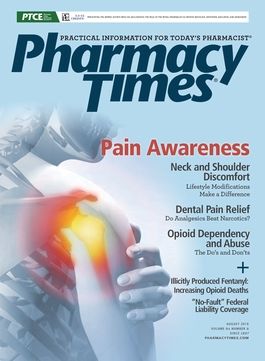Publication
Article
Pharmacy Times
Pharmacists: Frontline Fighters in the Opioid Abuse Crisis
Author(s):
Opioid abuse has reached epidemic proportions in the united states, with the rising number of opioid-related overdoses and deaths alarming drug manufacturers, health care providers, lawmakers, and patients alike.
Opioid abuse has reached epidemic proportions in the united states, with the rising number of opioid-related overdoses and deaths alarming drug manufacturers, health care providers, lawmakers, and patients alike.
The statistics paint a grim picture.
More than 200,000 individuals in the United States died because of prescription opioid overdoses between 1999 and 2016, with nearly 5 times as many such deaths occurring in 2016 compared with 1999, according to the CDC.1 The CDC also reported that opioid overdoses continued to increase in multiple states from July 2016 to September 2017.2
Amid the urgency of the situation, numerous attempts to curb opioid abuse have been made from multiple angles. In an effort to reduce inappropriate opioid prescriptions, the CDC published a new guideline on prescribing opioids for chronic pain in March 2016.3 To prevent patients from tampering with the drugs, the FDA has encouraged manufacturers to develop abuse-deterrent formulations of their most widely used opioids, and many such medications have already received the agency’s approval.4 In the legislative arena, Congress has discussed expanding the Comprehensive Addiction and Recovery Act of 2016, which called for establishing a federal task force intended to combat opioid abuse through education and treatment rather than criminal prosecution.5 All these potential solutions tackle only a small part of the larger problem, but together they may have an impact on opioid-related mortality.
Because of their accessibility and expertise, pharmacists are in many ways on the front lines of the opioid abuse epidemic and play an essential role in communicating concerns and sharing knowledge with other members of the health care team. Indeed, study results presented at PAINWeek 2017 concluded that patients with chronic pain achieved a reduction in opioid use when treated by an integrated team that included a pharmacist.6 Pharmacists can also provide naloxone, the lifesaving opioid overdose reversal medication reportedly used to save pop singer Demi Lovato’s life last month. The drug is available without a prescription in the majority of states, though recent research found that just 24% of pharmacists in Indiana community pharmacies had dispensed the drug.7
Additionally, as Pharmacy Times® contributing writer Jeffrey Fudin, PharmD, and his peers noted in a recent opinion piece, patients with a legitimate need for narcotic analgesics are too often caught in the crossfire during the fight against opioid abuse.8 Therefore, it is crucial that pharmacists continue to be advocates for those with chronic pain and work with prescribers to ensure that these patients receive the treatment they require.
To help pharmacists in this endeavor, this issue of Pharmacy Times® contains practical information on lower back pain, neck and shoulder pain, oral pain, and more, as well as a free continuing education activity on the varicella-zoster virus.
Thank you for reading, and remember, collaborating saves lives!
References
- Prescription Opioid Overdose Data. CDC website. Last updated August 1, 2017. cdc.gov/drugoverdose/data/overdose.html. Accessed June 25, 2018.
- Emergency Data Show Rapid Increases in Opioid Overdoses [news release]. CDC's website. cdc.gov/media/releases/2018/p0306-vs-opioids-overdoses.html. Accessed June 25, 2018.
- Dowell D, Haegerich T, Chou, R. CDC Guideline for Prescribing Opioids for Chronic Pain — United States, 2016. CDC website. Published March 15, 2016. cdc.gov/mmwr/volumes/65/rr/rr6501e1.htm. Accessed June 25, 2018.
- Abuse-Deterrent Opioid Analgesics. FDA website. Last updated April 23, 2018. fda.gov/Drugs/DrugSafety/PostmarketDrugSafetyInformationforPatientsandProviders/ucm600788.htm. Accessed June 25, 2018.
- Hill J, Topoleski C, Schulte-Wall J, Gentile N. Examining Critical Public Policy Issues Impacting Pharmacy Practice in the Last Half of the 115th Congress. Presented at: 2018 ASHP Summer Meetings and Exhibition. June 2-6, 2017. Denver, Colorado.
- Rife T, Tighe J, Li Y, Seal K. Improving Chronic Pain Care and Opioid Safety in VA Primary Care: Implementation and Evaluation of the Integrated Pain Team Clinic. Presented at: PainWeek 2017. September 5-9, 2017. Las Vegas.
- Meyerson BE, Agley JD, Davis A, et al. Predicting pharmacy naloxone stocking and dispensing following a statewide standing order, Indiana 2016. Drug Alcohol Depend. 2018:18; 187-192. doi: 10.1016/j.drugalcdep.2018.03.032.
- Fudin J, Ziegler S, Lewis T. Opinion: A Reaction to DEA's Efforts to Target Pharmacies With “Unusual” Opioid Prescription Rates. Pharmacy Times® website. Published February 5, 201 pharmacytimes.com/contributor/jeffrey-fudin/2018/02/opinion-a-reaction-to-deas-efforts-to-target-pharmacies-with-unusual-opioid-prescription-rates. Accessed June 28, 201






